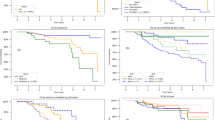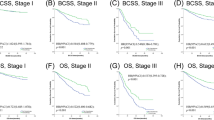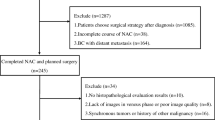Abstract
Background
The aim of this study was to develop a machine learning (ML) based model to accurately predict pathologic complete response (pCR) to neoadjuvant chemotherapy (NAC) using pretreatment clinical and pathological characteristics of electronic medical record (EMR) data in breast cancer (BC).
Methods
The EMR data from patients diagnosed with early and locally advanced BC and who received NAC followed by curative surgery were reviewed. A total of 16 clinical and pathological characteristics was selected to develop ML model. We practiced six ML models using default settings for multivariate analysis with extracted variables.
Results
In total, 2065 patients were included in this analysis. Overall, 30.6% (n = 632) of patients achieved pCR. Among six ML models, the LightGBM had the highest area under the curve (AUC) for pCR prediction. After hyper-parameter tuning with Bayesian optimization, AUC was 0.810. Performance of pCR prediction models in different histology-based subtypes was compared. The AUC was highest in HR+HER2- subgroup and lowest in HR−/HER2- subgroup (HR+/HER2- 0.841, HR+/HER2+ 0.716, HR−/HER2 0.753, HR−/HER2- 0.653).
Conclusions
A ML based pCR prediction model using pre-treatment clinical and pathological characteristics provided useful information to predict pCR during NAC. This prediction model would help to determine treatment strategy in patients with BC planned NAC.




Similar content being viewed by others
Data availability
Data can be made available upon request; some restrictions will apply.
References
Bray F, Ferlay J, Soerjomataram I, Siegel RL, Torre LA, Jemal A (2018) Global cancer statistics 2018: GLOBOCAN estimates of incidence and mortality worldwide for 36 cancers in 185 countries. CA Cancer J Clin 68:394–424. https://doi.org/10.3322/caac.21492
Siegel RL, Miller KD, Jemal A (2019) Cancer statistics, 2019. CA Cancer J Clin 69:7–34. https://doi.org/10.3322/caac.21551
Bonadonna G (1992) Evolving concepts in the systemic adjuvant treatment of breast cancer. Cancer Res 52:2127–2137
Cortazar P, Zhang L, Untch M, Mehta K, Costantino JP, Wolmark N, Bonnefoi H, Cameron D, Gianni L, Valagussa P, Swain SM, Prowell T, Loibl S, Wickerham DL, Bogaerts J, Baselga J, Perou C, Blumenthal G, Blohmer J, Mamounas EP, Bergh J, Semiglazov V, Justice R, Eidtmann H, Paik S, Piccart M, Sridhara R, Fasching PA, Slaets L, Tang S, Gerber B, Geyer CE Jr, Pazdur R, Ditsch N, Rastogi P, Eiermann W, von Minckwitz G (2014) Pathological complete response and long-term clinical benefit in breast cancer: the CTNeoBC pooled analysis. Lancet 384:164–172. https://doi.org/10.1016/S0140-6736(13)62422-8
von Minckwitz G, Untch M, Blohmer JU, Costa SD, Eidtmann H, Fasching PA, Gerber B, Eiermann W, Hilfrich J, Huober J, Jackisch C, Kaufmann M, Konecny GE, Denkert C, Nekljudova V, Mehta K, Loibl S (2012) Definition and impact of pathologic complete response on prognosis after neoadjuvant chemotherapy in various intrinsic breast cancer subtypes. J Clin Oncol 30:1796–1804. https://doi.org/10.1200/JCO.2011.38.8595
Symmans WF, Peintinger F, Hatzis C, Rajan R, Kuerer H, Valero V, Assad L, Poniecka A, Hennessy B, Green M, Buzdar AU, Singletary SE, Hortobagyi GN, Pusztai L (2007) Measurement of residual breast cancer burden to predict survival after neoadjuvant chemotherapy. J Clin Oncol 25:4414–4422. https://doi.org/10.1200/JCO.2007.10.6823
Schneeweiss A, Chia S, Hickish T, Harvey V, Eniu A, Hegg R, Tausch C, Seo JH, Tsai YF, Ratnayake J, McNally V, Ross G, Cortes J (2013) Pertuzumab plus trastuzumab in combination with standard neoadjuvant anthracycline-containing and anthracycline-free chemotherapy regimens in patients with HER2-positive early breast cancer: a randomized phase II cardiac safety study (TRYPHAENA). Ann Oncol 24:2278–2284. https://doi.org/10.1093/annonc/mdt182
Swain SM, Ewer MS, Viale G, Delaloge S, Ferrero JM, Verrill M, Colomer R, Vieira C, Werner TL, Douthwaite H, Bradley D, Waldron-Lynch M, Kiermaier A, Eng-Wong J, Dang C, BERENICE Study Group (2018) Pertuzumab, trastuzumab, and standard anthracycline- and taxane-based chemotherapy for the neoadjuvant treatment of patients with HER2-positive localized breast cancer (BERENICE): a phase II, open-label, multicenter, multinational cardiac safety study. Ann Oncol 29:646–653. https://doi.org/10.1093/annonc/mdx773
Wu J, Li S, Jia W, Su F (2011) Response and prognosis of taxanes and anthracyclines neoadjuvant chemotherapy in patients with triple-negative breast cancer. J Cancer Res Clin Oncol 137:1505–1510. https://doi.org/10.1007/s00432-011-1029-6
Kim H-E, Kim HH, Han B-K, Kim KH, Han K, Nam H, Lee EH, Kim E-K (2020) Changes in cancer detection and false-positive recall in mammography using artificial intelligence: a retrospective, multireader study. Lancet Digi Health 2:e138–e148. https://doi.org/10.1016/S2589-7500(20)30003-0
Wenbin Y, Wang Z, Chen H, Payne A, Liu X (2018) Machine learning with applications in breast cancer diagnosis and prognosis. Designs. https://doi.org/10.3390/designs2020013
Akay MF (2009) Support vector machines combined with feature selection for breast cancer diagnosis. Expert Syst Appl 36:3240–3247. https://doi.org/10.1016/j.eswa.2008.01.009
Edge SBBD, Compton CC, Fritz AG, Greene FL, Trotti A (eds) (2010) AJCC cancer staging manual, 7th edn. Springer, New York, NY
Onitilo AA, Engel JM, Greenlee RT, Mukesh BN (2009) Breast cancer subtypes based on ER/PR and Her2 expression: comparison of clinicopathologic features and survival. Clin Med Res 7:4–13. https://doi.org/10.3121/cmr.2009.825
Kohavi R (1995) A study of cross-validation and bootstrap for accuracy estimation and model selection. Morgan Kaufmann Publishers Inc, San Francisco, p 7
Snoek J, Hugo L, Adams RP (2012) Practical bayesian optimization of machine learning algorithms. Curran Associates Inc, New York, p 9
Terence Parr KT, Christopher C, Jeremy H (2018) Beware default random forest importances. http://parrt.cs.usfca.edu/doc/rf-importance/index.html
Bottini A, Berruti A, Tampellini M, Morrica B, Brunelli A, Gnocchi E, Brizzi MP, Aguggini S, Fara E, Alquati P, Dogliotti L (1997) Influence of neoadjuvant chemotherapy on serum tumor markers CA 15–3, MCA, CEA, TPS and TPA in breast cancer patients with operable disease. Tumour Biol 18:301–310. https://doi.org/10.1159/000218043
Wu SG, He ZY, Zhou J, Sun JY, Li FY, Lin Q, Guo L, Lin HX (2014) Serum levels of CEA and CA15-3 in different molecular subtypes and prognostic value in Chinese breast cancer. Breast 23:88–93. https://doi.org/10.1016/j.breast.2013.11.003
Lips EH, Mukhtar RA, Yau C, de Ronde JJ, Livasy C, Carey LA, Loo CE, Vrancken-Peeters MJ, Sonke GS, Berry DA, Van’t Veer LJ, Esserman LJ, Wesseling J, Rodenhuis S, Shelley Hwang E, Investigators IST (2012) Lobular histology and response to neoadjuvant chemotherapy in invasive breast cancer. Breast Cancer Res Treat 136:35–43. https://doi.org/10.1007/s10549-012-2233-z
Mamounas EP, Bryant J, Lembersky B, Fehrenbacher L, Sedlacek SM, Fisher B, Wickerham DL, Yothers G, Soran A, Wolmark N (2005) Paclitaxel after doxorubicin plus cyclophosphamide as adjuvant chemotherapy for node-positive breast cancer: results from NSABP B-28. J Clin Oncol 23:3686–3696. https://doi.org/10.1200/JCO.2005.10.517
Rastogi P, Anderson SJ, Bear HD, Geyer CE, Kahlenberg MS, Robidoux A, Margolese RG, Hoehn JL, Vogel VG, Dakhil SR, Tamkus D, King KM, Pajon ER, Wright MJ, Robert J, Paik S, Mamounas EP, Wolmark N (2008) Preoperative chemotherapy: updates of national surgical adjuvant breast and bowel project protocols B-18 and B-27. J Clin Oncol 26:778–785. https://doi.org/10.1200/JCO.2007.15.0235
Petrelli F, Coinu A, Borgonovo K, Cabiddu M, Ghilardi M, Lonati V, Barni S (2014) The value of platinum agents as neoadjuvant chemotherapy in triple-negative breast cancers: a systematic review and meta-analysis. Breast Cancer Res Treat 144:223–232. https://doi.org/10.1007/s10549-014-2876-z
Hamy AS, Belin L, Bonsang-Kitzis H, Paquet C, Pierga JY, Lerebours F, Cottu P, Rouzier R, Savignoni A, Lae M, Reyal F (2016) Pathological complete response and prognosis after neoadjuvant chemotherapy for HER2-positive breast cancers before and after trastuzumab era: results from a real-life cohort. Br J Cancer 114:44–52. https://doi.org/10.1038/bjc.2015.426
Houssami N, Macaskill P, von Minckwitz G, Marinovich ML, Mamounas E (2012) Meta-analysis of the association of breast cancer subtype and pathologic complete response to neoadjuvant chemotherapy. Eur J Cancer 48:3342–3354. https://doi.org/10.1016/j.ejca.2012.05.023
Mougalian SS, Soulos PR, Killelea BK, Lannin DR, Abu-Khalaf MM, DiGiovanna MP, Sanft TB, Pusztai L, Gross CP, Chagpar AB (2015) Use of neoadjuvant chemotherapy for patients with stage I to III breast cancer in the United States. Cancer 121:2544–2552. https://doi.org/10.1002/cncr.29348
Mayer IA, Abramson VG, Lehmann BD, Pietenpol JA (2014) New strategies for triple-negative breast cancer–deciphering the heterogeneity. Clin Cancer Res 20:782–790. https://doi.org/10.1158/1078-0432.CCR-13-0583
Dieci MV, Miglietta F, Griguolo G, Guarneri V (2020) Biomarkers for HER2-positive metastatic breast cancer: beyond hormone receptors. Cancer Treat Rev 88:102064. https://doi.org/10.1016/j.ctrv.2020.102064
Imamura M, Morimoto T, Nomura T, Michishita S, Nishimukai A, Higuchi T, Fujimoto Y, Miyagawa Y, Kira A, Murase K, Araki K, Takatsuka Y, Oh K, Masai Y, Akazawa K, Miyoshi Y (2018) Independent prognostic impact of preoperative serum carcinoembryonic antigen and cancer antigen 15–3 levels for early breast cancer subtypes. World J Surg Oncol 16:26. https://doi.org/10.1186/s12957-018-1325-6
Harris L, Fritsche H, Mennel R, Norton L, Ravdin P, Taube S, Somerfield MR, Hayes DF, Bast RC Jr, American Society of Clinical Oncology (2007) American society of clinical oncology 2007 update of recommendations for the use of tumor markers in breast cancer. J Clin Oncol 25:5287–5312. https://doi.org/10.1200/JCO.2007.14.2364
Landmann A, Farrugia DJ, Zhu L, Diego EJ, Johnson RR, Soran A, Dabbs DJ, Clark BZ, Puhalla SL, Jankowitz RC, Brufsky AM, Ahrendt GM, McAuliffe PF, Bhargava R (2018) Low estrogen receptor (ER)-positive breast cancer and neoadjuvant systemic chemotherapy: is response similar to typical ER-positive or ER-negative disease? Am J Clin Pathol 150:34–42. https://doi.org/10.1093/ajcp/aqy028
Sheri A, Smith IE, Hills M, Jones RL, Johnston SR, Dowsett M (2017) Relationship between IHC4 score and response to neo-adjuvant chemotherapy in estrogen receptor-positive breast cancer. Breast Cancer Res Treat 164:395–400. https://doi.org/10.1007/s10549-017-4266-9
van Mackelenbergh MT, Denkert C, Nekljudova V, Karn T, Schem C, Marme F, Stickeler E, Jackisch C, Hanusch C, Huober J, Fasching PA, Blohmer JU, Kummel S, Muller V, Schneeweiss A, Untch M, von Minckwitz G, Weber KE, Loibl S (2018) Outcome after neoadjuvant chemotherapy in estrogen receptor-positive and progesterone receptor-negative breast cancer patients: a pooled analysis of individual patient data from ten prospectively randomized controlled neoadjuvant trials. Breast Cancer Res Treat 167:59–71. https://doi.org/10.1007/s10549-017-4480-5
Konecny G, Pauletti G, Pegram M, Untch M, Dandekar S, Aguilar Z, Wilson C, Rong HM, Bauerfeind I, Felber M, Wang HJ, Beryt M, Seshadri R, Hepp H, Slamon DJ (2003) Quantitative association between HER-2/neu and steroid hormone receptors in hormone receptor-positive primary breast cancer. J Natl Cancer Inst 95:142–153. https://doi.org/10.1093/jnci/95.2.142
Dowsett M, Harper-Wynne C, Boeddinghaus I, Salter J, Hills M, Dixon M, Ebbs S, Gui G, Sacks N, Smith I (2001) HER-2 amplification impedes the antiproliferative effects of hormone therapy in estrogen receptor-positive primary breast cancer. Cancer Res 61:8452–8458
Pathological Complete Response in Neoadjuvant Treatment of High-Risk Early-Stage Breast Cancer: Use as an Endpoint to Support Accelerated Approval Guidance for Industry (2020). https://www.fda.gov/drugs/guidance-compliance-regulatory-information/guidances-drugs
Kim JY, Park D, Son DS, Nam SJ, Kim SW, Jung HH, Kim YJ, Park G, Park WY, Lee JE, Park YH (2017) Circulating tumor DNA shows variable clonal response of breast cancer during neoadjuvant chemotherapy. Oncotarget 8:86423–86434. https://doi.org/10.18632/oncotarget.21198
Moss J, Zick A, Grinshpun A, Carmon E, Maoz M, Ochana BL, Abraham O, Arieli O, Germansky L, Meir K, Glaser B, Shemer R, Uziely B, Dor Y (2020) Circulating breast-derived DNA allows universal detection and monitoring of localized breast cancer. Ann Oncol 31:395–403. https://doi.org/10.1016/j.annonc.2019.11.014
Bownes RJ, Turnbull AK, Martinez-Perez C, Cameron DA, Sims AH, Oikonomidou O (2019) On-treatment biomarkers can improve prediction of response to neoadjuvant chemotherapy in breast cancer. Breast Cancer Res 21:73. https://doi.org/10.1186/s13058-019-1159-3
Funding
This work was supported by Institute for Information and Communications Technology Promotion grant funded by the Korean government (2018-0-00861, Intelligent SW Technology Development for Medical Data Analysis) and grants from the National Research Foundation of Korea (NRF-2020R1F1A1072616).
Author information
Authors and Affiliations
Contributions
YI and JK conceived and planned the experiments. JK, EJ and HJ carried out analyses and experiments. JK, JEL, SJN, YHP, JSA and YI contributed to collection of samples and clinical data. JK, EJ, HJ, SK, SJ and YP contributed to the interpretation of the results. JK, EJ and YI took the lead in writing the manuscript. YI supervised the project. All authors reviewed and confirmed the manuscript.
Corresponding author
Ethics declarations
Conflict of interest
The authors have no competing interests to declare.
Ethical approval
This study was reviewed and approved by the Institutional Review Board (IRB) of Samsung Medical Center, Seoul, Korea (IRB No. 2019–04-021).
Consent to participate
The requirement for individual informed consent was waived because of the retrospective clinical data review. This study was performed in accordance with the Declaration of Helsinki.
Consent to publish
All authors have agreed to the content of the manuscript and provided consent regarding its publication.
Additional information
Publisher's Note
Springer Nature remains neutral with regard to jurisdictional claims in published maps and institutional affiliations.
Supplementary Information
Below is the link to the electronic supplementary material.
10549_2021_6310_MOESM1_ESM.tif
Supplementary file1 (TIF 767 KB) Supplementary Figure 1 Correlation between all features. pCR—pathologic complete response, Menopause—menopausal status, HER2—human epidermal growth factor receptor 2, Chemo—chemotherapy regimen, IDC_or_Not—histology, Co_Cancer—Comorbidity (Cancer), Co_Hepatitis—Comorbidity (Hepatitis), Co_Metabolic—Comorbidity (Metabolic), Co_CVD—Comorbidity (cerebrovascular disease), Co_others—Comorbidity (others), ER_score—estrogen receptor, PR_score—progesterone receptor, cstageN—clinical stage
Rights and permissions
About this article
Cite this article
Kim, JY., Jeon, E., Kwon, S. et al. Prediction of pathologic complete response to neoadjuvant chemotherapy using machine learning models in patients with breast cancer. Breast Cancer Res Treat 189, 747–757 (2021). https://doi.org/10.1007/s10549-021-06310-8
Received:
Accepted:
Published:
Issue Date:
DOI: https://doi.org/10.1007/s10549-021-06310-8




